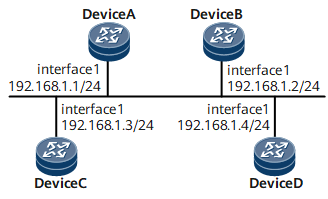Example for Configuring OSPF Fast Convergence
This section describes how to configure OSPF fast convergence by adjusting the timer parameter and configuring BFD.
Networking Requirements
On the network shown in Figure 1, on the broadcast network, OSPF runs on the four devices, which belong to the same OSPF area.
Precautions
When configuring OSPF fast convergence, note the following rules:
You can decrease the interval at which Hello packets are sent and values of the Dead, Poll, and Wait timers for fast OSPF network convergence. Frequent packet transmission, however, may overload the device. In addition, the OSPF network convergence slows down if the values of these timers are too large. Therefore, set values based on the network stability.
- The intervals at which Hello packets are sent and values of the Dead, Poll, and Wait timers at both ends must be the same. Otherwise, the OSPF neighbor relationship cannot be established.
Configuration Roadmap
The configuration roadmap is as follows:
Configure basic OSPF functions on each router for interconnection.
Configure the BFD function on each router.
Adjust the holddown time of the OSPF neighbors on each router.
Configure the Smart-discover function on each router.
Adjust the intervals for configuration update, LSA reception, and SPF calculation through an intelligent timer on each router.
Data Preparation
To complete the configuration, you need the following data.
Holddown time of the OSPF neighbors
Intervals for LSA update, LSA reception, and SPF calculation
Procedure
- Assign an IP address to each interface. For configuration details, see Configuration Files in this section.
- Configure basic OSPF functions. For details, see Example for Configuring Basic OSPF Functions.
- Adjust the holddown time of the OSPF neighbors on each router.
# Configure Device A.
[~DeviceA] interface gigabitethernet 0/1/0 [*DeviceA-GigabitEthernet0/1/0] ospf timer dead 30 [*DeviceA-GigabitEthernet0/1/0] commit

The holddown time of neighbors of the OSPF-capable interfaces must be longer than the interval at which Hello packets are sent, and the values of dead interval on the routers in the same network segment must be the same.
In this configuration example, the following configurations on each router are the same as that on Device A. For configuration details, see "Configuration Files" in this section.
Adjust the holddown time of the OSPF neighbors on each router.
Configure the Smart-discover function on each router.
Adjust the intervals for configuration update, LSA reception, and SPF calculation through an intelligent timer on the router.
- Configure the Smart-discover function on each router.
# Configure Device A.
[*DeviceA-GigabitEthernet0/1/0] ospf smart-discover [*DeviceA-GigabitEthernet0/1/0] commit [~DeviceA-GigabitEthernet0/1/0] quit
- Configure the BFD function on each router.
# Configure Device A.
[*DeviceA] bfd [*DeviceA-bfd] quit [*DeviceA] ospf [*DeviceA-ospf-1] bfd all-interfaces enable [*DeviceA-ospf-1] commit [~DeviceA-ospf-1] quit
- Adjust the intervals for configuration update, LSA reception, and SPF calculation through an intelligent timer on each router.
# Configure Device A.
[~DeviceA] ospf 1 [*DeviceA-ospf-1] lsa-originate-interval intelligent-timer 3000 200 500 [*DeviceA-ospf-1] lsa-arrival-interval intelligent-timer 3000 200 500 [*DeviceA-ospf-1] spf-schedule-interval intelligent-timer 3000 200 500 [*DeviceA-ospf-1] commit
- Verify the configuration.
# Run the display ospf brief command on each router to view the brief information about OSPF. Use Router A as an example. You can view the value of timers.
[~DeviceA] display ospf brief OSPF Process 1 with Router ID 9.9.9.9 OSPF Protocol Information RouterID: 9.9.9.9 Border Router: AREA Multi-VPN-Instance is not enabled Global DS-TE Mode: Non-Standard IETF Mode Graceful-restart capability: disabled Helper support capability : not configured OSPF Stub Router State Reason: Startup Synchronize Router LSA stub links with cost 65535 Summary LSA with cost 16777214 External LSA with cost 16777214 Applications Supported: MPLS Traffic-Engineering Spf-schedule-interval: max 10000ms, start 500ms, hold 1000ms Default ASE parameters: Metric: 1 Tag: 1 Type: 2 Route Preference: 10 ASE Route Preference: 150 Intra Route Preference: 50 Inter Route Preference: 50 SPF Computation Count: 56 RFC 1583 Compatible Retransmission limitation is disabled bfd enabled BFD Timers: Tx-Interval 10 , Rx-Interval 10 , Multiplier 3 Area Count: 2 Nssa Area Count: 0 ExChange/Loading Neighbors: 0 Area: 0.0.0.0 MPLS TE not enabled Authtype: None Area flag: Normal SPF scheduled count: 2 Exchange/Loading neighbors: 0 Router ID conflict state: Normal Interface: 1.1.1.1 (GE0/1/17) Cost: 1 State: DR Type: Broadcast MTU: 1500 Priority: 1 Designated Router: 1.1.1.1 Backup Designated Router: 0.0.0.0 Timers: Hello 10, Dead 40, Wait 40, Poll 120, Retransmit 5, Transmit Delay 1
Configuration Files
Device A configuration file
# sysname DeviceA # router id 1.1.1.1 # bfd # interface GigabitEthernet0/1/0 undo shutdown ip address 192.168.1.1 255.255.255.0 ospf timer dead 30 ospf smart-discover # ospf 1 bfd all-interfaces enable spf-schedule-interval intelligent-timer 3000 200 500 lsa-arrival-interval intelligent-timer 3000 200 500 lsa-originate-interval intelligent-timer 3000 200 500 area 0.0.0.0 network 192.168.1.0 0.0.0.255 # return
Device B configuration file
# sysname DeviceB # router id 2.2.2.2 # bfd # interface GigabitEthernet0/1/0 undo shutdown ip address 192.168.1.2 255.255.255.0 ospf timer dead 30 ospf smart-discover # ospf 1 bfd all-interfaces enable spf-schedule-interval intelligent-timer 3000 200 500 lsa-arrival-interval intelligent-timer 3000 200 500 lsa-originate-interval intelligent-timer 3000 200 500 area 0.0.0.0 network 192.168.1.0 0.0.0.255 # return
Device C configuration file
# sysname DeviceC # router id 3.3.3.3 # bfd # interface GigabitEthernet0/1/0 undo shutdown ip address 192.168.1.3 255.255.255.0 ospf timer dead 30 ospf smart-discover # ospf 1 bfd all-interfaces enable spf-schedule-interval intelligent-timer 3000 200 500 lsa-arrival-interval intelligent-timer 3000 200 500 lsa-originate-interval intelligent-timer 3000 200 500 area 0.0.0.0 network 192.168.1.0 0.0.0.255 # return
Device D configuration file
# sysname DeviceD # router id 4.4.4.4 # bfd # interface GigabitEthernet0/1/0 undo shutdown ip address 192.168.1.4 255.255.255.0 ospf timer dead 30 ospf smart-discover # ospf 1 bfd all-interfaces enable spf-schedule-interval intelligent-timer 3000 200 500 lsa-arrival-interval intelligent-timer 3000 200 500 lsa-originate-interval intelligent-timer 3000 200 500 area 0.0.0.0 network 192.168.1.0 0.0.0.255 # return
